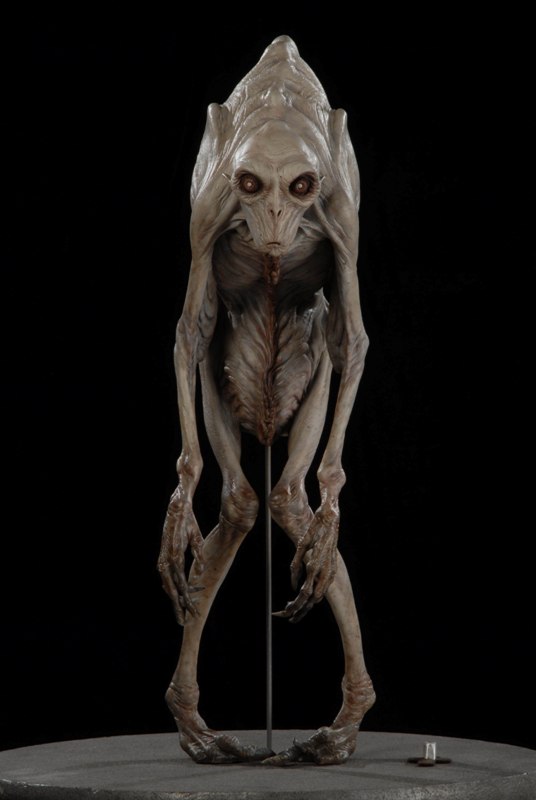This article originally appeared in IF Magazine #142 (August-September 2011).
There is no more fertile territory than the mind of filmmaker Guillermo Del Toro – a place where grotesque and bizarre horror is regularly shaped into creatures never before seen on screen.
Films such as Pan’s Labyrinth, Hellboy and Blade II present entire worlds that shock as well as entertain by stretching the boundaries of the imagination. The 10-inch ‘homunculi’ that populate Melbourne-filmed horror Don’t Be Afraid of the Dark – first inspired by the 1970s made-for-TV film of the same name – are just the latest in a long-line of creatures dredged from Del Toro’s mind.
The original telemovie used a variety of effects to shrink heavily-masked actors to pint-sized beings, which then terrorise a family who have moved into an old mansion.
“Guillermo had intended to do exactly that,” says Spectral Motion founder and long time Del Toro collaborator Mike Elizalde of the remake – “to have us make maquettes and have us build prosthetic pieces and body suits that would be performed by actors.
“We used a couple of techniques on Hellboy 2 that were very effective, which was to put an actor into a suit and then create a set of legs or limbs that weren’t human, in proportion or size, and then erase the rest of the actor’s body. Guillermo had also used this to good effect in Pan’s Labyrinth.”
Spectral Motion started by creating several maquettes – some about eight inches tall and some at about two feet in height to show more detail. Each one took about two-and-a-half weeks to create.
“And then it was decided after a few passes of the budget, and other people weighed in, that it would be done digitally,” Elizalde says, noting that all-CGI creatures were also likely to make the process easier for first-time director Troy Nixey. With Del Toro in New Zealand, where he was (at that time) slated to write and direct fantasy epic The Hobbit, plans were made to shift the production to Australia, opening the door for Australian VFX houses to become involved.
Iloura was one of several local companies to meet Del Toro and the team in New Zealand, as the production searched for a local effects house that could transform Spectral Motion’s maquettes into realistic CGI creatures.
“We did a lot of preliminary art work and documents to not only prove our credentials, but also prove our eagerness to do the work,” Iloura’s creative director Glenn Melenhorst says. “After that meeting in New Zealand we came back and invested time and energy into doing a test where we generated little creatures and filmed a little sequence of shots here on the stairs out the back of the building.”
That four-to-five second high-definition sequence – which showed two small creatures venturing into the light and looking around before picking up a little nail and scampering off – was enough to win the contract. With scans of Spectral Motion’s models in hand, Iloura began by putting its team through ‘homunculus’ school. The goal was to create natural, realistic movements “so it wasn’t basically an animated maquette,” Melenhorst says.
The company used Autodesk’s MAYA and then rendered the characters in VRAY in MAX, also using 3D Lite for the hair. Iloura’s on-set supervisor Julian Dimsey oversaw the shoot, which began in July 2009, to ensure that all VFX-requirements were met. At the same time, Melenhorst’s team were back in the studio creating pre-visualisation sequences one to two days ahead of principal photography.
“We would turnaround 40-something shots a day and cut that into a sequence and then discuss it with Troy and Guillermo and the benefits of that,” Melenhorst says. “Then that turned into photography a few days later, so it was really a dynamic workflow on set.”
Del Toro eventually returned from New Zealand on a regular basis to oversee the production, directing some key sequences himself to ensure his vision was realised. Some scenes in the film required about 80 homunculi creating chaos although Iloura initially concentrated on eight core characters.
“What we ended up doing was painting countless numbers of skin textures, and then timing numbers of different hair, timing of patterns and hair and cuts etc,” he says. “So while they look like they’re all kind of from the same family, they’re all quite different.”
Iloura ultimately created about 70 creature shots and between 60 – 70 production fixes over the nine months following the end of the shoot. While the film became mired in studio politics after Disney sold Miramax, delaying the film’s release for several months, the entire crew walked away with glowing reports about Del Toro.
Melenhorst says the filmmaker laid the foundation for “probably my best VFX experience ever” because of his clear communication and belief in the team around him. “There’ll always be a story-point reason he doesn’t like it, never technical, because he’ll trust us to do what we do best,” he says. “So basically he gave us the confidence to do that while he related to the film purely from a creative story point.”
Don’t Be Afraid of the Dark was released in Australia by Hopscotch Films in 2011 and is available on DVD.


